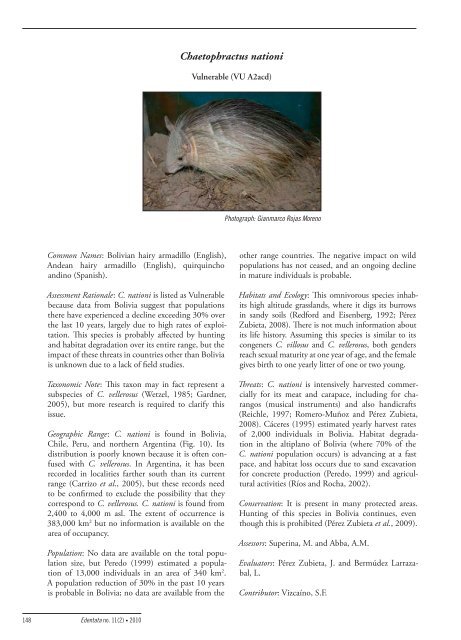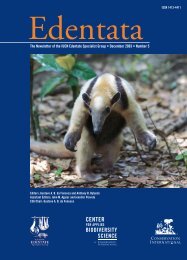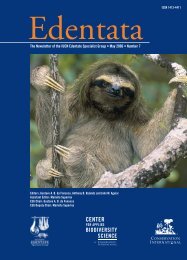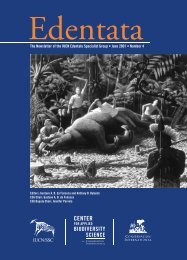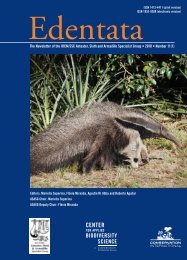Edentata 11(2), 2010 - Anteater, Sloth & Armadillo Specialist Group
Edentata 11(2), 2010 - Anteater, Sloth & Armadillo Specialist Group
Edentata 11(2), 2010 - Anteater, Sloth & Armadillo Specialist Group
- No tags were found...
Create successful ePaper yourself
Turn your PDF publications into a flip-book with our unique Google optimized e-Paper software.
Chaetophractus nationiVulnerable (VU A2acd)Photograph: Gianmarco Rojas MorenoCommon Names: Bolivian hairy armadillo (English),Andean hairy armadillo (English), quirquinchoandino (Spanish).Assessment Rationale: C. nationi is listed as Vulnerablebecause data from Bolivia suggest that populationsthere have experienced a decline exceeding 30% overthe last 10 years, largely due to high rates of exploitation.This species is probably affected by huntingand habitat degradation over its entire range, but theimpact of these threats in countries other than Boliviais unknown due to a lack of field studies.Taxonomic Note: This taxon may in fact represent asubspecies of C. vellerosus (Wetzel, 1985; Gardner,2005), but more research is required to clarify thisissue.Geographic Range: C. nationi is found in Bolivia,Chile, Peru, and northern Argentina (Fig. 10). Itsdistribution is poorly known because it is often confusedwith C. vellerosus. In Argentina, it has beenrecorded in localities farther south than its currentrange (Carrizo et al., 2005), but these records needto be confirmed to exclude the possibility that theycorrespond to C. vellerosus. C. nationi is found from2,400 to 4,000 m asl. The extent of occurrence is383,000 km 2 but no information is available on thearea of occupancy.Population: No data are available on the total populationsize, but Peredo (1999) estimated a populationof 13,000 individuals in an area of 340 km 2 .A population reduction of 30% in the past 10 yearsis probable in Bolivia; no data are available from theother range countries. The negative impact on wildpopulations has not ceased, and an ongoing declinein mature individuals is probable.Habitats and Ecology: This omnivorous species inhabitshigh altitude grasslands, where it digs its burrowsin sandy soils (Redford and Eisenberg, 1992; PérezZubieta, 2008). There is not much information aboutits life history. Assuming this species is similar to itscongeners C. villosus and C. vellerosus, both gendersreach sexual maturity at one year of age, and the femalegives birth to one yearly litter of one or two young.Threats: C. nationi is intensively harvested commerciallyfor its meat and carapace, including for charangos(musical instruments) and also handicrafts(Reichle, 1997; Romero-Muñoz and Pérez Zubieta,2008). Cáceres (1995) estimated yearly harvest ratesof 2,000 individuals in Bolivia. Habitat degradationin the altiplano of Bolivia (where 70% of theC. nationi population occurs) is advancing at a fastpace, and habitat loss occurs due to sand excavationfor concrete production (Peredo, 1999) and agriculturalactivities (Ríos and Rocha, 2002).Conservation: It is present in many protected areas.Hunting of this species in Bolivia continues, eventhough this is prohibited (Pérez Zubieta et al., 2009).Assessors: Superina, M. and Abba, A.M.Evaluators: Pérez Zubieta, J. and Bermúdez Larrazabal,L.Contributor: Vizcaíno, S.F.148<strong>Edentata</strong> no. <strong>11</strong>(2) • <strong>2010</strong>


